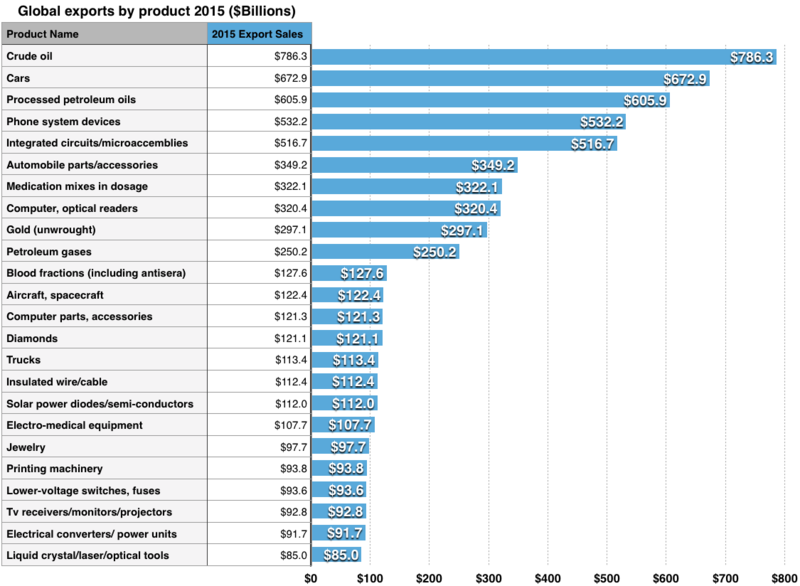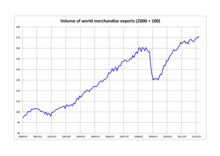In most countries, such trade represents a significant share of gross domestic product (GDP). While international trade has existed throughout history (for example Uttarapatha, Silk Road, Amber Road, scramble for Africa, Atlantic slave trade, salt roads), its economic, social, and political importance has been on the rise in recent centuries.
Carrying out trade at an international level is a complex process when compared to domestic trade. When trade takes place between two or more nations factors like currency, government policies, economy, judicial system, laws, and markets influence trade.
To smoothen and justify the process of trade between countries of different economic standing, some international economic organisations were formed, such as the World Trade Organization. These organisations work towards the facilitation and growth of international trade. Statistical services of intergovernmental and supranational organisations and national statistical agencies publish official statistics on international trade.
Characteristics of global trade
A product that is transferred or sold from a party in one country to a party in another country is an export from the originating country, and an import to the country receiving that product. Imports and exports are accounted for in a country's current account in the balance of payments.Trading globally may give consumers and countries the opportunity to be exposed to new markets and products. Almost every kind of product can be found in the international market, for example: food, clothes, spare parts, oil, jewellery, wine, stocks, currencies, and water. Services are also traded, such as in tourism, banking, consulting, and transportation.
Advanced technology (including transportation), globalisation, industrialisation, outsourcing and multinational corporations have major impacts on the international trade system.
Increasing international trade is crucial to the continuance of globalisation. Countries would be limited to the goods and services produced within their own borders without international trade. International trade benefits many countries in various aspects. In the case of Vizio’s flat-panel TVs, the manufacturing leadership has been shifting from one country to another due to global economic growth. At first, Japan could assemble the components of this TV and sell it out to the other countries such as US. However, recession affected Japan and South Korea took the lead in assembling the parts of this TV. Samsung played a critical role in the selling and manufacturing of the flat TV. Taiwan also took advantage of the recession that affected South Korea and the investors assembled electronic components of Vizio’s flat-panel TVs. At first the US suffered from this cycle because despite inventing this business idea, other countries implemented it in the international market. Chinese eventually started manufacturing flat TVs at a lower cost compared to the previous investors. It is important to note that US benefited from the cycle because many investors could manufacture the TV at lower cost (Kandel, Kosenko, Morck & Yafeh, 2013). China is also another country that benefited from this business because it started manufacturing the product late at a lower price. South Korea and Japan suffered from the global recession because it was expensive to manufacture Vizio’s flat-panel TVs at the beginning.
Despite the benefits that many countries enjoyed from selling Vizio’s flat-panel TVs, many nations suffered due to changes in international economy. Some countries experienced recessions that could not favor the manufacture of this product. For example, Japan became the first country to sell the flat-panel screens in 1990s but decade-long recession affected the business operations and surrendered to South Korea. It is also important to note that South Korea suffered the same fate from the Asian crisis in 1997 (Lazarev, 2007). Mexico is one lucky country that never suffered the consequences of crisis. The country could assemble flat-panel TVs after sourcing the electronic parts from other countries (Hill & Hult, 2019). In this regard, it is clear that countries that took part in the manufacture of these TVs were affected in different ways.
The US played a critical role in the invention and manufacture of the flat-panel TVs. In this regard, the decision made by the US may affect the entrepreneurs at the local and international level. If the US government demands that flat-panel displays be sold in the country only, the investors will have to sell the products at lower prices. It is clear that the prices of these flat-panel displays are cheap in the US compared to the countries. In addition, the local investors will not have the opportunity to compete at international level (Kandel, Kosenko, Morck & Yafeh, 2013). The quality of the screens can be compromised because the local manufacturers do not encounter foreign competitors.
The future production of these TVs will change. Technology is changing the mode of production from one year to another. For instance, the manufacture of these TVs began from assembling electronic parts from different countries. However, things have changed and currently, every country is aiming at using the local resources to manufacture the screens.
Differences from domestic trade
Ports play an important role in facilitating international trade. The Port of New York and New Jersey grew from the original harbor at the convergence of the Hudson River and the East River at the Upper New York Bay.
International trade is, in principle, not different from domestic trade as the motivation and the behavior of parties involved in a trade do not change fundamentally regardless of whether trade is across a border or not.
However, in practical terms, carrying out trade at an international level is typically a more complex process than domestic trade. The main difference is that international trade is typically more costly than domestic trade. This is due to the fact that a border typically imposes additional costs such as tariffs, time costs due to border delays, and costs associated with country differences such as language, the legal system, or culture (non-tariff barriers).
Another difference between domestic and international trade is that factors of production such as capital and labor are often more mobile within a country than across countries. Thus, international trade is mostly restricted to trade in goods and services, and only to a lesser extent to trade in capital, labour, or other factors of production. Trade in goods and services can serve as a substitute for trade in factors of production. Instead of importing a factor of production, a country can import goods that make intensive use of that factor of production and thus embody it. An example of this is the import of labor-intensive goods by the United States from China. Instead of importing Chinese labor, the United States imports goods that were produced with Chinese labor. One report in 2010 suggested that international trade was increased when a country hosted a network of immigrants, but the trade effect was weakened when the immigrants became assimilated into their new country.
History
The history of international trade chronicles notable events that have affected trading among various economies.Theories and models
There are several models which seek to explain the factors behind international trade, the welfare consequences of trade and the pattern of trade.Most traded export products
Largest countries by total international trade
Volume of world merchandise exports
| Rank | Country | International trade of goods (billions of USD) |
International trade of services (billions of USD) |
Total international trade of goods and services (billions of USD) |
|---|---|---|---|---|
| – | World | 32,430 | 9,635 | 42,065 |
| – | 3,821 | 1,604 | 5,425 | |
| 1 | 3,706 | 1,215 | 4,921 | |
| 2 | 3,686 | 656 | 4,342 | |
| 3 | 2,626 | 740 | 3,366 | |
| 4 | 1,066 | 571 | 1,637 | |
| 5 | 1,250 | 350 | 1,600 | |
| 6 | 1,074 | 470 | 1,544 | |
| 7 | 1,073 | 339 | 1,412 | |
| 8 | 1,064 | 172 | 1,236 | |
| 9 | 902 | 201 | 1,103 | |
| 10 | 866 | 200 | 1,066 | |
| 11 | 807 | 177 | 984 | |
| 12 | 763 | 212 | 975 | |
| 13 | 623 | 294 | 917 | |
| 13 | 613 | 304 | 917 | |
| 15 | 771 | 53 | 824 | |
| 16 | 596 | 198 | 794 | |
| 17 | 572 | 207 | 779 | |
| 18 | 511 | 93 | 604 | |
| 19 | 473 | 122 | 595 | |
| 20 | 248 | 338 | 586 | |
| 21 | 491 | 92 | 583 |
Top traded commodities by value (exports)
| Rank | Commodity | Value in US$('000) | Date of information |
|---|---|---|---|
| 1 | Mineral fuels, oils, distillation products, etc. | $2,183,079,941 | 2015 |
| 2 | Electrical, electronic equipment | $1,833,534,414 | 2015 |
| 3 | Machinery, nuclear reactors, boilers, etc. | $1,763,371,813 | 2015 |
| 4 | Vehicles other than railway | $1,076,830,856 | 2015 |
| 5 | Plastics and articles thereof | $470,226,676 | 2015 |
| 6 | Optical, photo, technical, medical, etc. apparatus | $465,101,524 | 2015 |
| 7 | Pharmaceutical products | $443,596,577 | 2015 |
| 8 | Iron and steel | $379,113,147 | 2015 |
| 9 | Organic chemicals | $377,462,088 | 2015 |
| 10 | Pearls, precious stones, metals, coins, etc. | $348,155,369 | 2015 |




